On a sandy stretch of land in southwest Somalia, several hundred people disembarked trucks, their eyes taking in the barren, makeshift camp that will be their new home. Among them was Halima Ismael Ibrahim, a skinny single mother of 10.
“We left to save ourselves,” Ibrahim tells me the next day, as she cradled her youngest boy, a crying two-year-old, under the beating 40-degree sun they still had no respite from. She recalled how her family’s goats, camels and donkeys had collapsed and died from lack of food and water.
Ibrahim’s family walked for three days, accompanied by her sister-in-law, who is breastfeeding a newborn. From there, they were able to board trucks rented by good Samaritans to take what had become a group of nearly 300 people, all displaced by drought.
'These people's livelihoods are gone, so what next? A dignified way of life is gone. That is climate change'
“I kept hearing from other people that there are organisations in Dullow giving out things, so this was the destination,” says Ibrahim. “Relatives paid for the trucks, we told them we would pay them back later. I’ve never moved away from my home, this is the first time, but over the last two years we kept feeling like it was coming, it was getting worse every year.”
Eleven years ago, Somalia’s famine – the first big famine of the 21st century – killed a quarter of a million people, half of them children under the age of six. Unlike then, phones are now readily available in the countryside, so people who have lost everything else still manage to communicate, sharing information on where aid might be available. That is how this group ended up in Dullow, a Somali town of roughly 60,000 right on the Ethiopian border, where about 20 local and international organisations are operating.
Survivors of Ibrahim’s journey said two children and a man died in the vehicles en route: their bodies were buried by the side of the road. The new arrivals – mostly women and children, and a few dozen men – slept, unsheltered, on the ground they were dropped off on.
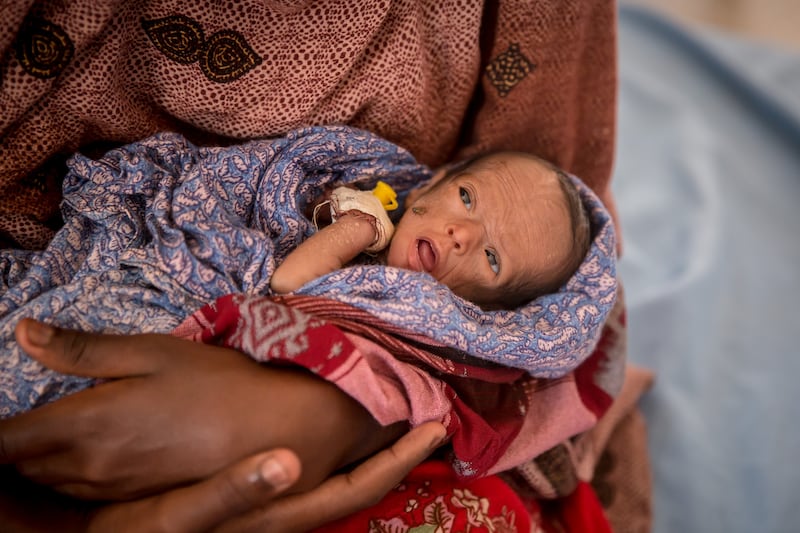
The story of Somalia's drought is one of climate change, a failure of the federal government and western indifference. Three consecutive rains have failed in a country said to be one of the most vulnerable to the climate crisis on Earth. The fourth – expected in mid-April – has still not arrived. The result is that an estimated six million Somalis are now experiencing extreme levels of food insecurity, and 81,000 people across six areas are already thought to be experiencing famine.
The coming months are expected to be worse. But international attention is elsewhere – not least on the war in Ukraine, which has driven up food and fuel prices across Africa. A humanitarian response plan, aimed at feeding the hungry and saving lives, is only 4.4 per cent funded.
Harsh climate is nothing new to Somalis. In A Land of Drought, one of the country’s most famous 19th century poets, Seyyid Mohamed Abdulle Hassan, wrote of livestock facing ground where “teeth will find no food to chew” as “a rotting carcass . . . proves to be that of a man or a woman or a child”.
However, experts say the situation is becoming much more extreme, with mean annual temperatures expected to increase by about 3 degrees this century. Rainfall is increasingly unpredictable, less regular and more intense when it does fall, which can lead to failed harvests, soil erosion and flash flooding.
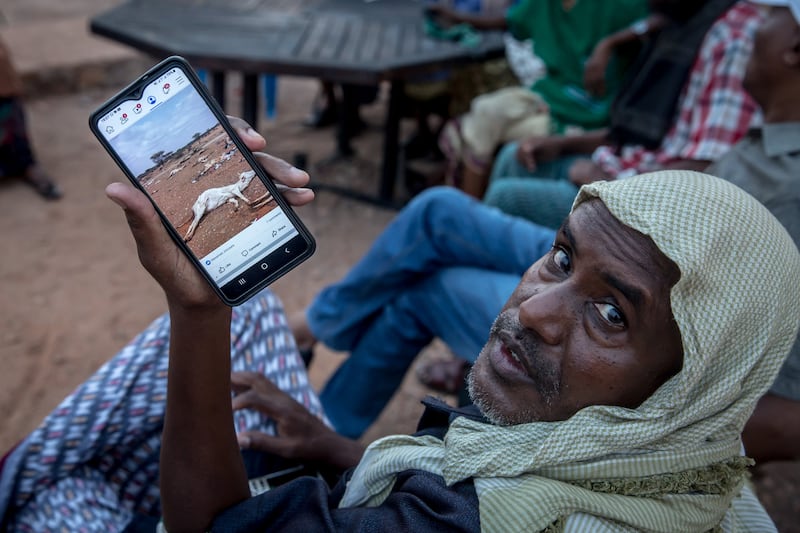
Conflict is one likely consequence, as people fight over scarce grazing opportunities and water sources. Drought has driven 745,000 people from their homes since the end of last year, according to the UN, which projects that the number may rise to more than one million by the middle of 2022.
Pastoralism has been a way of life for much of this population for generations. Once their animals die, displaced people face an existential crisis: what does the future hold for them now? “These people’s livelihoods are gone, so what next? A dignified way of life is gone. That is climate change. It is directly attributable to climate change,” says Paul Healy, the country director at Trócaire, which operates in Dullow.
Somalis have a culture of sharing with others in need. During Ramadan, particularly, charity is common. But that goodwill is also being tested.
'They don't get enough food, shelter. Sanitation is poor ... The water they're drinking is not clean'
The night before we met, villagers brought food and water for the nearly 300 new arrivals in Qansahley camp, where Ibrahim ended up. But they were a few hundred among tens of thousands, and more arrive each day. Abdiya Barre Ali, the local area chief, is using her own land to house 2,000 families. “I’m 70 years old and I have not seen a drought like this one,” she says. “We are worried. Even tonight we don’t know what we will give them. Of course it’s not enough.”
In nearby Kabasa camp, a young boy searched through a makeshift rubbish dump for scrap metal which he could sell for a pittance. A girl, only slightly taller than the first boy, pushed a wheelbarrow ahead of her, piling up anything she spotted that might have a value.
This camp is now home to more than 40,000 people.
Four medics sat in a small two-room health centre constructed of wood and corrugated metal. They were hired by Trócaire on four-month contracts – charged with spotting the most urgent medical cases from among the displaced and sending them to the hospital. But the bar for “urgent” is high.
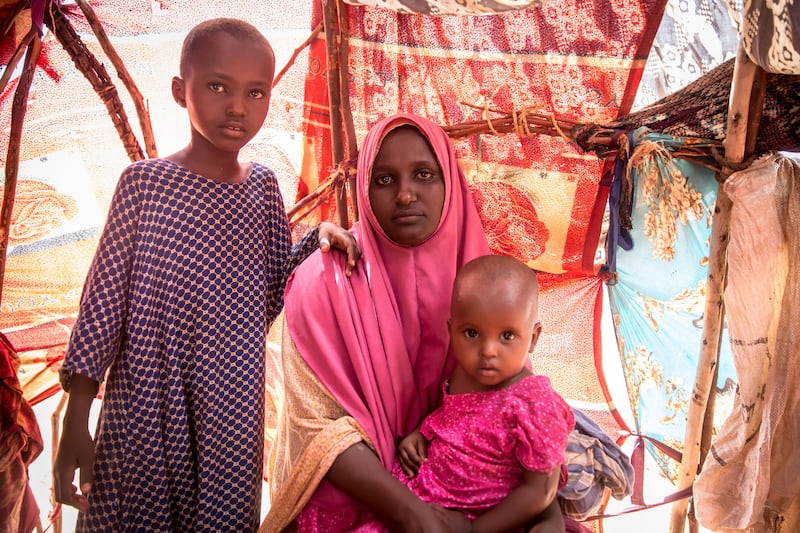
At a time when almost everyone is struggling to eat, this has created a conundrum for people who suffer through each day listening to their children’s hungry cries and know the small amount of food they can procure is not nutritious enough for growing bodies.
Medics measure each child’s arm to evaluate how malnourished they are; if they are deemed to be in need, they are referred to hospital and assigned a month-long course of the therapeutic food Plumpy’Nut. One of Trócaire’s staff says sometimes parents deliberately keep food from their children so they reach the necessary threshold, resulting in a course of Plumpy’Nut that is meant for one but is shared among the whole family.
Adam Mohamed Dakne, a clinical nurse, says they see as many as 50 children a day, as well as a few dozen adults. “We don’t have time to ask about their histories,” he says. “They don’t get enough food, shelter. Sanitation is poor ... The water they’re drinking is not clean.”
Large swathes of Somalia are controlled by Islamic militant group Al-Shabaab, which was formed in 2006. Their existence, and US measures against them once they were designated as a terrorist group, exacerbated the effects of the 2011 famine. Aid agencies were frightened of providing assistance that might be accessed by them, and remittances sent by Somalis living abroad faced extra blocks.

Today, the al-Qaeda-aligned group – who ban foreign entities from entering their territory – still create tough challenges for humanitarian organisations. Desperate people living under their control are forced to leave to reach assistance. Many escapees speak of the group in a coded way, calling them “the boys” or “S”. But they also wonder whether they need to be included in the drought response – conditions for civilians in areas under their control, or places where fighting is ongoing, are unimaginable, they say, and that is not being properly documented.
Authorities echo this. “If this drought continues, for sure we will receive a lot of people who will come to this area and this is a problem,” Aden Bare Ali, the deputy district commissioner for Dullow, tells me. He suggests using businesspeople to distribute aid to Al-Shabaab-controlled areas – while the militants will not take it from foreigners, they would be more receptive to locals, he says.
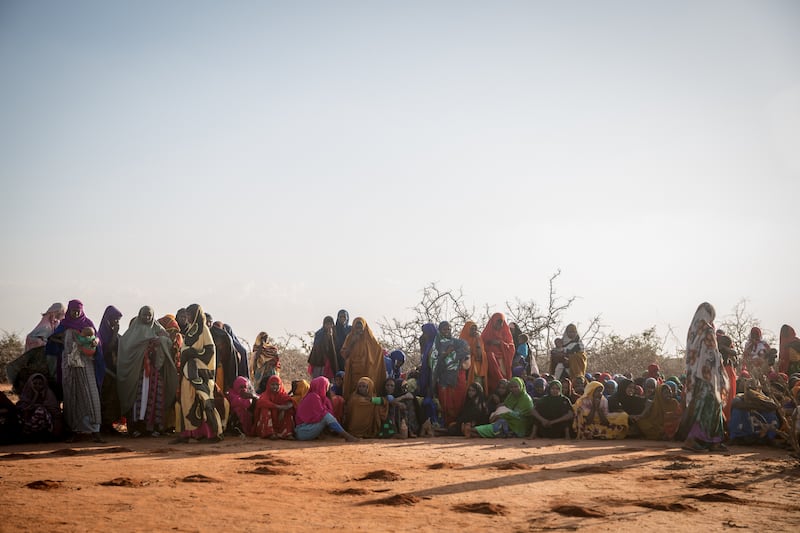
Just a month ago, Mariam Abdi Mohamed was under Al-Shabaab’s control. The 20-year-old mother of six says the group was trying to recruit everyone around them, including her husband. “If [anyone] didn’t join they would be slaughtered, it was daily,” she says.
The family’s 20 sheep succumbed to hunger and thirst. Sitting in a buul – the small round shelter, made of branches and pieces of fabric, which is her new home – she mourns two of her children, who she says died on the road to Dullow. “We know Dullow is peaceful and there’s a functioning government, and there are many NGOs,” she says. “I don’t imagine going back there in the current situation, the problem is still there and I’ve lost all my livelihood now.”
Despite her escape, she has received no aid, except some rice given by local Somalis. Three of her remaining children sit around her, one crying in front of an empty pot. “Only God will help me,” Mohamed says.
Her direct neighbour, Madina Muktar (30), says two of her four children died on the way to the camp, as well as her husband. Ten of her goats perished during the drought. The journey from Dinsoor, which was under Al-Shabaab control, took them 10 days of walking. “The boys don’t allow aid,” she recalls, “and people are fighting over water.” Al-Shabaab took over dams which were used by pastoralists during previous dry seasons, Muktar says. “I need shelter, food and any humanitarian assistance. I’m not willing to go back, my husband and two kids are dead.”

In Ladhan camp, newly arrived people have gone from praying for the rain to fearing it. There are only five toilets for 1,313 households, meaning the camp will be turned into an open sewer and a breeding ground for disease if the expected April rains begin soon.
Katra Aden Abdi, a 27-year-old with two children, says she has spent 10 months there. Her husband stayed behind, 60km away, to mind their few remaining animals. “We still communicate but he has nothing to offer us. It’s worse there now.” She says Al-Shabaab believe that if they allow any NGO or charity to operate in the area, “others will follow them and they will be attacked. They don’t care about people affected.”
Famine is a political word with a specific meaning, and the international community is slow to declare it because certain criteria must be met and – more problematic – that data must be gathered. In 2011, Somalia was the first country to meet the requirements of a famine using measurements created under the Integrated Food Security Phase Classification (IPC) scale, which was developed by the UN’s Food and Agriculture Organisation in the early 2000s.
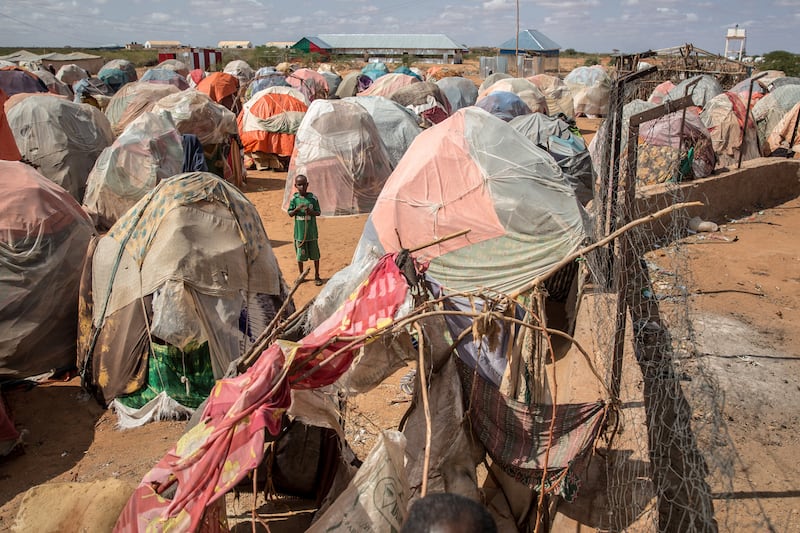
Now, a “famine” means that at least 20 per cent of households have a complete lack of food and other basic needs, more than 30 per cent of children are acutely malnourished, and two people per 10,000 are dying each day. That threshold has not been met in recent years of drought in Somalia, though the level of suffering has still been extreme by most understandings of the word.
Now, the UN has warned that 350,000 children could die by the summer of this year if nothing is done to help them. A famine declaration would hugely assist in attracting international donations and funding. But data in Somalia can be rough for a host of reasons: it is not even clear whether many of the deaths experienced by families I spoke to were investigated or officially counted. Some aid workers worry that if a declaration comes, it will be too late.
'We're only applying for humanitarian aid ...We left our home because the drought is recurrent. We don't have anything'
In a health facility in Dullow, doctors say they are not overwhelmed, but they are getting close to it. “This is the worst thing I’ve ever encountered,” says Dr Shueb Ali, who has worked there for 2½ years. “It is very upsetting, it is quite challenging to see.”
Nearby was Istar Mohamed Abdi (20), whose malnourished 16-month-old boy had been admitted for treatment. Abdi said she had lived in Kabasa camp since the 2011 famine. “I want some assistance. The drought has affected everyone,” she says.
On another bed was a 15-year-old girl who recently crossed the border from Ethiopia, where drought is also badly affecting people. Her baby, at just 12 days old, had a wrinkled face and an impossibly small body, even after three days in the facility. "At home there was nothing," the girl says, explaining that she could not produce milk for the baby.
Exacerbating the danger is a measles outbreak, which has gone on for four months and spread among the camps. Though measles is transmitted through air, there is no capacity to isolate patients, according to Dr Ali, and “almost everyone has it now”. One admitted mother even died from measles, he says.
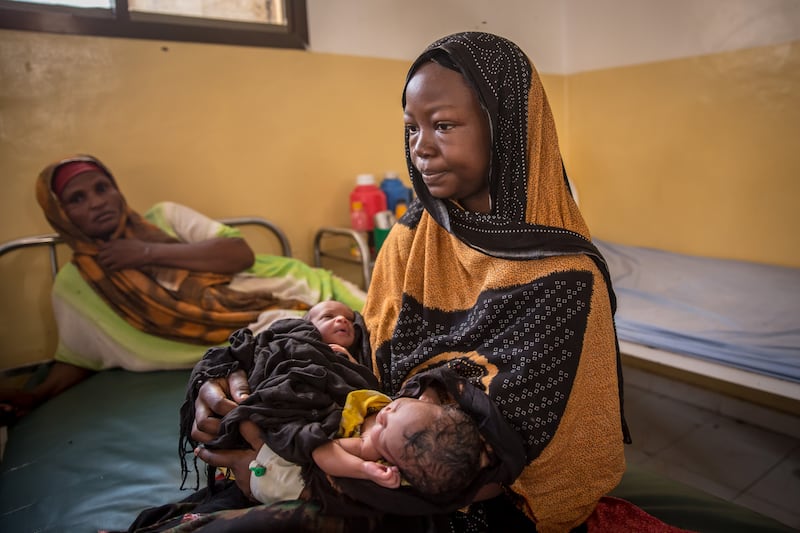
Somalia’s drought has been so devastating that even normally happy news is no longer a cause for celebration. In the health centre’s maternity ward, one day after giving birth to twin girls, 19-year-old Hane Issack is downcast, worrying about how she will feed them once she returns to the camp she has lived in for seven years. Her own mother, watching on, explains she has a donkey and cart that she uses to transport goods, but it isn’t enough to support the family.
An aid worker speculates that the babies will “most likely” be back in the malnutrition clinic at some point soon.
“We’re only applying for humanitarian aid,” Issack says, her babies squirming beside her. “We left our home because the drought is recurrent. We don’t have anything.”




















